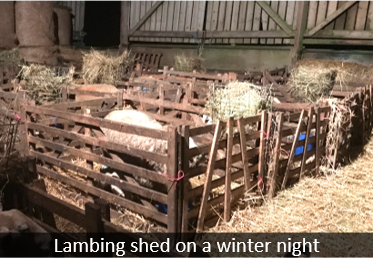Farming News: On Lambing – March 2021
by Malcolm Barker
I have often wondered, as I crouch upon the floor beside a newborn animal, what it is which causes them to take that first breath. Up to now they have had a supply of oxygenated blood from their mother via the umbilical cord but at parturition this is broken. I assume that a chemical imbalance in the brain causes the newborn to take that first gasp for air, but the afterbirth must be removed from the mouth and nose for this to be successful. This is always my priority after delivering a lamb or a calf. Usually, the mother licks the newborn’s face clean but if the mother is exhausted then I wipe it clear with my hand.
 The next task is to check that the animal is breathing and does it have a pulse? If the heart is beating then the pulse is visible to the side of the abdomen, slightly forward of the back leg, not in the thorax where you might expect to see a heartbeat. If the animal doesn’t take that first breath, and many don’t, then the so called ‘experts’ tell you to tickle the animal’s nose with some straw. This advice must have caused the needless death of millions of animals over the years. I have found that the surest way to stimulate a lamb, or calf to take that first gulp of air is to insert a finger to the back of the animal`s throat and this stimulates a sucking reflex in the newborn and by this method it takes its first breath.
The next task is to check that the animal is breathing and does it have a pulse? If the heart is beating then the pulse is visible to the side of the abdomen, slightly forward of the back leg, not in the thorax where you might expect to see a heartbeat. If the animal doesn’t take that first breath, and many don’t, then the so called ‘experts’ tell you to tickle the animal’s nose with some straw. This advice must have caused the needless death of millions of animals over the years. I have found that the surest way to stimulate a lamb, or calf to take that first gulp of air is to insert a finger to the back of the animal`s throat and this stimulates a sucking reflex in the newborn and by this method it takes its first breath.
At this point I carry the lamb to the front of the mother where she can lick it clean. If a twin is born this is usually around 15 minutes later and a triplet might be 5 minutes after that. I spray iodine onto the lamb’s navel at this point to prevent bacteria from the floor entering the bloodstream and killing the lamb within a few days.
Once the sheep has lambed, I carry the lambs, getting the sheep to follow me, through a door into an adjacent shed. Here the new family is housed in one of several individual pens where the lambs can get to know their mother’s smell and can find where to feed from her. It is good practice to make sure that each lamb takes about 200 sucks of colostrum from its mother within the first hour of its life. The ewe, at this time is still talking to her new lambs and teaching them to recognise her voice.
The family are kept in this pen for a couple of days and provided that the lambs are thriving, I spray a number onto the side of each animal to identify that the sheep numbered 1 is the mother of the lambs with the number marked on their sides. From now on the sheep and lambs are taken to larger pens where they mix together but are still kept indoors until the weather warms and the grass starts to grow. By the time that the sheep and lambs go out into the fields the lambs have grown larger and are wise enough to not be taken by foxes.
This year’s lambing is now mostly over. Most of my sheep lambed during the snowy week in early February. They seem to do this on purpose. They never like to give birth in good weather but hang on waiting for heavy rain or snow.
Occasionally a ewe rejects one or both of her lambs. I then need to fasten her into a ‘lamb adopter’. This is a crate which holds the sheep by her neck in a place where she can stand or lie down but she cannot turn around to butt the lambs away. The lambs can drink from her whenever they want and have an area to lie down at either side of her. After a few days the sheep usually accepts her lambs.
